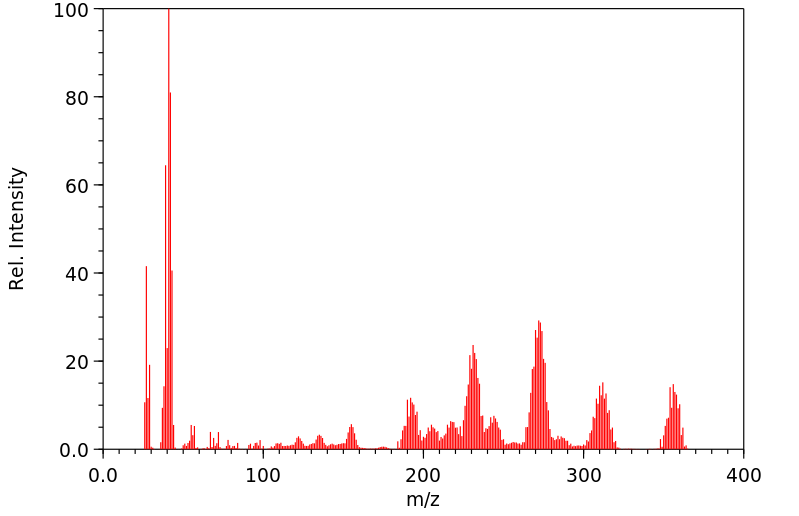Mo2(endo-μ2-η3-allyl)(exo-μ2-allyl)(endo-η3-allyl)2
中文名称
——
中文别名
——
英文名称
Mo2(endo-μ2-η3-allyl)(exo-μ2-allyl)(endo-η3-allyl)2
英文别名
——
CAS
——
化学式
C12H20Mo2
mdl
——
分子量
356.171
InChiKey
MLANELDPTCHMIJ-UHFFFAOYSA-N
BEILSTEIN
——
EINECS
——
-
物化性质
-
计算性质
-
ADMET
-
安全信息
-
SDS
-
制备方法与用途
-
上下游信息
-
文献信息
-
表征谱图
-
同类化合物
-
相关功能分类
-
相关结构分类
计算性质
-
辛醇/水分配系数(LogP):3.43
-
重原子数:14
-
可旋转键数:0
-
环数:0.0
-
sp3杂化的碳原子比例:0.0
-
拓扑面积:0
-
氢给体数:0
-
氢受体数:0
反应信息
-
作为反应物:描述:Mo2(endo-μ2-η3-allyl)(exo-μ2-allyl)(endo-η3-allyl)2 在 CO 作用下, 以 正戊烷 为溶剂, 以90%的产率得到molybdenum hexacarbonyl参考文献:名称:Blau, Reed J.; Siriwardane, Upali, Organometallics, 1991, vol. 10, # 5, p. 1627 - 1630摘要:DOI:
-
作为产物:描述:氯丙烯镁 、 乙酸钼(II)二聚体 在 methanol 作用下, 以 乙醚 为溶剂, 以3.4%的产率得到Mo2(endo-μ2-η3-allyl)(exo-μ2-allyl)(endo-η3-allyl)2参考文献:名称:Blau, Reed J.; Goetz, Mary S.; Howe, Ronda R., Organometallics, 1991, vol. 10, # 9, p. 3259 - 3266摘要:DOI:
文献信息
-
Selective protonation of terminally bound η3-allyls on (η3-allyl)2(μ2-η3-allyl)2dimolybdenum(II) by β-diketones forming(μ2-η3a-allyl)2(η2-β-diketonate)2 dimolybdenum(II) complexes作者:Reed J. Blau、Mary S. Goetz、Rong-Jer TsayDOI:10.1016/s0277-5387(00)83619-0日期:1991.1The beta-diketones, R(C = O)CH2(C = O)R' [where R = R' = Me (acac); R = Me, R' = CF3 (tfac); or R = R' = CF3 (hfac)] selectively protonate the terminally bound eta-3-allyls on Mo2(mu-2-eta-3-allyl)2(eta-3-allyl)2 (A) leaving the Mo2(mu-2-eta-3-allyl)2 core intact. The molybdenum(II) dimers, Mo2(mu-2-eta-3-allyl)2(eta-2-L)2 [where L = acac (B), tfac (C) or hfac (D)] are formed from this reaction. From H-1, C-13 and F-19 NMR data, it is evident that the two bridging allyls in each complex, B-D, are bound in a cis arrangement with endo and exo conformations, respectively. Thus, a plane of symmetry bisects the Mo-Mo bond axis and the two bridging allyls in B and D, but is absent parallel to the Mo-Mo bond axis and bisecting each of the chelating beta-diketonate ligands. The complex, C, exists primarily as the isomer in which the bulky trifluoromethyl groups on the two tfac ligands are as far apart as possible from each other. As the electron-donating ability of the terminally bound ligands in A-D decreases, allyl > acac > tfac > hfac, an upfield shift in the proton resonances of the bridging allyls is observed.
表征谱图
-
氢谱1HNMR
-
质谱MS
-
碳谱13CNMR
-
红外IR
-
拉曼Raman
-
峰位数据
-
峰位匹配
-
表征信息
同类化合物
黄原酸环癸酯
高纯三甲基锑
顺式-二氯二(环丙胺)铂(II)
顺式-二氯二(乙二胺)氯化铑(1+)
顺式-二(环己基丁氨合)二氯铂(II)
顺式-二(异丙基氨合)二氯铂(II)
顺式-(2-氨基甲基-1-环戊基氨合)二氯铂(II)
顺二氯二羰基铂(II)
顺-二氯双(乙二胺)氯化铱
雷(酸)汞[含水或水加乙醇≥20]
间碳硼烷-9-硫醇
镍,加合(7:2)钪
镉二(二戊基二硫代氨基甲酸盐)
镁,溴-6-庚烯基-
manganese carbide
butyl manganese bromide
锡烷,氯二环己基-
锡四丁醇
锑,(1:1)混合物和钪
锌叔-丁氧化物
锌,溴-1-丙烯基-,(E)-
锇,加合(2:1)钪
锆酸四丁酯
锂丁酯
锂4-异丙氧基-2-甲基-丁烷-2-醇
锂1-丁醇
锂(三氟甲基)乙炔化物
锂(3-氨基丙基)酰胺
铼五羰基碘化物
铼五羰基
银(I)2-羟基乙烷-1-硫醇盐
铯三氯三羰基锇
铬三乙二胺
铬,五羰基(环己胺)-,(OC-6-22)-
铬,二(乙酰腈)二氯-
铝,加合(3:1)钪
铜-乙二胺络合物
铜(II)乙二胺
铜(I)乙炔化物
铍,环戊-1,3-二烯,溴化
铊N,N-二正丁胺
铊,甲氧基二甲基-
铂(2+)二氯化3-甲基丁烷-1,2-二胺(1:1)
铁(3+)三(1-丁醇)
铁(2+)1,1'-(硫烷二基二-1,1-乙二基)二-2,4-环戊二烯化
铀,三甲基-
钾,[三(三甲基甲硅烷基)甲基]-
钴四异硫氰酸酯
钴,乙烷-1,2-二胺
钠辛基二硫代氨基甲酸酯







